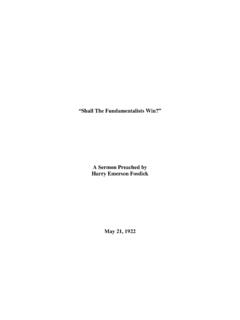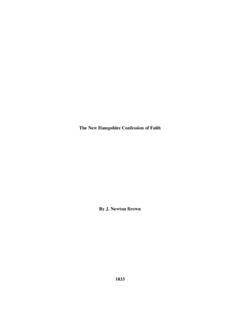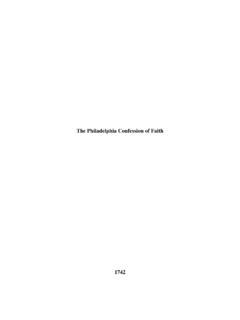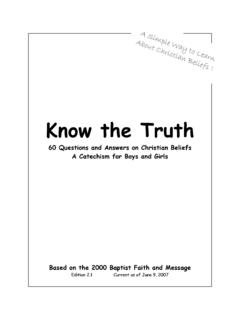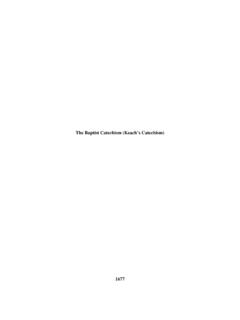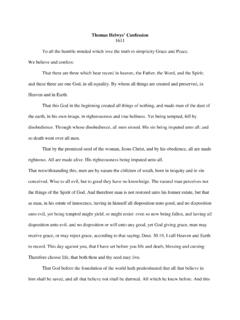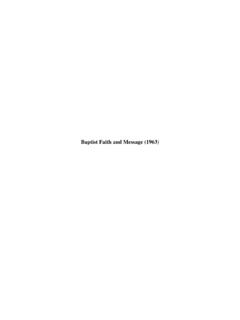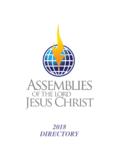Transcription of AN ORTHODOX CREED
1 AN ORTHODOX CREED : OR, A PROTESTANT CONFESSION OF FAITH. BEING AN ESSAY to Unite, and Confirm all true Protestants in the Fundamental Articles of the Christian Religion, against the Errors and Heresies of the Church of ROME. Rom. 10. 10. With the Heart Man believeth unto Righteousness, and with the Mouth confession is made unto Salvation. Jude, 3. That you should earnestly contend for the Faith, which was once delivered unto the Saints. Chrys. Hom. 13. on 2 Cor. I beseech you, regard not what this, or that Man saith, but inquire all things of the Scripture. LONDON, Printed in the year, 1679. A Baptist Historical Resource Published by the Center for Theological Research at 2006 Transcription by Madison Grace Permissions: The purpose of this material is to serve the churches.
2 Please feel free to distribute as widely as possible. We ask that you maintain the integrity of the document and the author s wording by not making any alterations and by properly citing any secondary use of this transcription. The Center for Theological Research Southwestern Baptist Theological Seminary Fort Worth, Texas Malcolm B. Yarnell, III, Director The ORTHODOX CREED General Baptists, 1679 Editor s Preface The seventeenth century in England was fraught with a plethora of political and religious problems. With the rise and fall of Oliver Cromwell s protectorate, and the subsequent institution of many acts from Parliament that attacked those who would not conform to the Church of England, Dissenters, especially Baptists, found themselves in a very precarious situation.
3 In an effort to show agreement with other Protestants, especially with Presbyterians and Congregationalists, lengthy confessions were published by both General and Particular Baptists. The most famous of these confessions, for the Particular Baptists, is the Second London Confession of 1677, subsequently revised in 1689. The Second London Confession was modeled after the Westminster Confession in hopes of presenting a unified Protestantism. However, the General Baptists also attempted to model a confession after the Westminster Confession, and the result of that attempt is The ORTHODOX CREED of 1679. The ORTHODOX CREED was written, as stated in the Advertisment to the Reader, for the counties of Bucks, Hertford, Bedford, and Oxford; however, it was never adopted by the General Assembly, which is why it may not have enjoyed as wide a popularity among General Baptists as the Second London Confession enjoyed among Particular Baptists.
4 The lack of adoption by the General Assembly does not diminish the importance of this document, for it is a clear representation of the beliefs and practices of the seventeenth-century General Baptists in England. The reproduction of The ORTHODOX CREED , for the first time since it was originally published, includes the Preface, the Advertisement to the Reader, containing the signatures, and the Postscript. These three pieces are integral for a correct understanding of the document, for in them, especially the Preface, one sees the underlying reasons for the following 50 articles. The Preface also makes clear the attempt of these General Baptists to align themselves religiously and politically with other ORTHODOX Protestants seeking acceptance in the kingdom. So why have these three pieces not been included before? The answer to that question resides with the publishing of Thomas Crosby s History of the English Baptists in 1738-1740.
5 It is in volume 3 of Crosby s seminal history that The ORTHODOX CREED was first Moreover, it is from Crosby s work that all subsequent editions Underhill,2 McGlothlin,3 and Lumpkin,4 and George5 of the CREED have been copied. 1 Thomas Crosby, History of the English Baptists From the Reformation to the Beginning of the Reign of King George I, Vol. III (London: 1739) Appendix. 2 Edward Bean Underhill, Confessions of Faith, and Other Public Documents, Illustrative of the History of the Baptist Churches of England in the 17th Century, (London: Haddon, Brothers, and Co., 1854) 121-168. McGlothlin, Baptist Confessions of Faith (Philadelphia, PA: American Baptist Publication Society, 1911). i The ORTHODOX CREED General Baptists, 1679 Crosby only included the 50 articles of the piece, and subsequent editors, relying exclusively upon Crosby, also include only the articles.
6 Adam Taylor, another early Baptist historian, said that it is lamentable that Crosby would leave out the signatures in his Joseph Ivimey concurs with Taylor and further accuses Crosby, because of his omissions, of, attempting to amalgamate all the Baptists into one denomination, and therefore he has endeavoured to prevent the General and the Particular Baptists from being distinguished. 7 The tradition of following Crosby s work as the authoritative version of the CREED is more problematic than merely omitting the Preface and the other pieces. As Crosby was adding this CREED to his volume, he took the liberty of reformatting it. Although he did not change any of the words in the document, nevertheless his changes, however miniscule, at times changed the meaning and left the document devoid of particular emphases which the original authors included.
7 First, Crosby, in attempt to modernize the grammar, decided to reinterpret the comma placement of the original. Article XX, Of the Free-will in Man , for example, speaks of the relationship between the first and second covenants. The original reads, according to the tenure of the new Covenant of Grace in Christ, though not perfectly according to the tenure of the First Covenant. Crosby s rendering of this section is, according to the tenure of the new covenant of grace in Christ, tho not perfectly, according to the tenure of the first covenant. The difference between the two is small in space, but important in impact, for the original has perfectly modifying according, whereas, Crosby has perfectly modifying the entire clause. The difference in the placement of the comma changes the meaning. Note also Article XIX, Of the agreement between the Old and New Testament.
8 The last line of this article has in the original the phrase, and hold forth the self-same Gospel-Salvation to them and us. There is one congruent thought, yet Crosby inserts a comma between Gospel and Salvation creating a short pause and a break of thought. In changing the usage of commas, as well as semi-colons, Crosby altered the construction of thought the General Baptists originally included. Instances such as these are scattered throughout Crosby s reproduction and, subsequently, all previous reproductions. Second, the original document is replete with capitalized words that would not normally be treated as proper nouns. Words like man, will, and face are capitalized, as context demands, in the original manuscript.
9 As one reads through the confession, one sees that these capitalized words are the important ideas and main subjects of the particular articles. Through capitalization, the General Baptists were placing emphasis upon these ideas. Yet, Crosby chose to remove most of the capitalization found in the original, and thus the theological import assigned by the authors is lessened. 4 William L. Lumpkin, Baptist Confessions of Faith (Valley Forge, VA: Judson Press, 1959). 5 Timothy George, Denise George, eds., Baptist Confessions, Covenants, and Catechisms (Nashville, TN: Broadman & Holman Publishers, 1996). 6 Adam Taylor, The History of the English General Baptists Vol. I (London: 1818) 225-226. 7 Joseph Ivimey, The History of the English Baptists Vol. II (London: 1814) 90-91. ii The ORTHODOX CREED General Baptists, 1679 Crosby s version of The ORTHODOX CREED , as a whole, is an adequate reproduction for introductory purposes.
10 However, Crosby s revisions have not only changed certain meanings for careful theological readers of his edition, but also for the readers of the Underhill, McGlothlin, Lumpkin, and George editions. The version of the CREED reproduced here has been transcribed from the original publication rather than the editorial tradition. The punctuation, capitalization, and spelling have been transcribed as published in the 1679 original, and the important front and back matter have been included for the first time in a modern edition. Madison Grace Southwestern Baptist Theological Seminary November 2006 iii The ORTHODOX CREED General Baptists, 1679 TO THE Judicious and Impartial READER Courteous Reader, THE truly Ancient and Apostolical Faith, that1 was once delivered unto the Saints, by our Lord Jesus Christ, and miraculously confirmed unto us, by Signs, and Wonders, and divers Gifts of the Holy Ghost,2according to the good pleasure of Almighty God.
